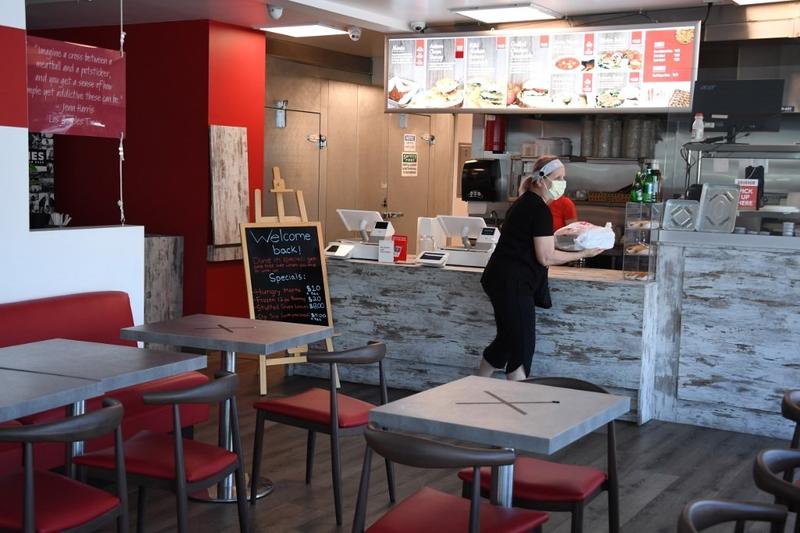 A customer carries out a take away meal at the Armenian cuisine restaurant Monta Factory on July 2, 2020 in Glendale, California, after Los Angeles County restaurants were force by state order to shut their doors again to dine-in eating due to a spike in COVID-19 cases. (ROBYN BECK / AFP)
A customer carries out a take away meal at the Armenian cuisine restaurant Monta Factory on July 2, 2020 in Glendale, California, after Los Angeles County restaurants were force by state order to shut their doors again to dine-in eating due to a spike in COVID-19 cases. (ROBYN BECK / AFP)
After several months of uncertainty, Brittney Valles, co-owner of Guerrilla Tacos, a restaurant in downtown Los Angeles, was finally ready to welcome diners back inside. She devoted two weeks to training staff and bought personal protective equipment.
It’s like a roller coaster. Depending on what rule is in place with the county, we will see it directly affect our business, up and down.
Brittney Valles, coowner of Guerrilla Tacos
"We had five glorious hours of being open, and we had all of our staff back, and we were prepared to get in full swing again," she said."Unfortunately, we had to close that same day."
In response to the rapidly increasing number of novel coronavirus infections and hospitalizations in California, Governor Gavin Newsom on July 1 ordered restaurants in 19 of the state's hardest-hit counties, including Los Angeles County, to end indoor operations.
ALSO READ: US hits record with over 77,000 cases of COVID-19 in one day
That order was followed by a new directive on Monday that extended the indoor dining restriction to all counties.
Restaurant owners in California and nationwide have dealt with a decline of sales, ever-increasing rents and often confusing guidelines as officials tightened restrictions to contain the pandemic.
According to the National Restaurant Association, a Washington-based trade group that represents more than 500,000 restaurant businesses, the industry is on track to lose $240 billion in sales in 2020.
Since the pandemic hit, sales at Valles' Mexican restaurant have plummeted 25 percent, even with a solid takeout business, she said. She also had to furlough staff.
Valles then decided to open a small coffee shop next door and hired several workers for that. Despite the coronavirus disruptions, business at the takeout-only coffee shop is going full steam. It usually sees around 60 to 70 patrons in the first three hours it is open.
Biggest challenge
But the biggest challenge for Valles has been to adapt to the new rules enacted by officials during the rapidly evolving pandemic.
"Every month or every week, there's a new guideline that we have to follow, or there are new numbers of cases, so then they closed certain aspects of our business down, or they opened them, and they closed them again," she said.
When the state shuttered dine-in service, takeout sales soared. Once the government lifted restrictions on indoor dining, demand for takeout dramatically decreased as more restaurants reopened.
"It's like a roller coaster. Depending on what rule is in place with the county, we will see it directly affect our business, up and down," Valles said.
Patrick Mulvaney, owner and chef of Mulvaney's Building & Loan, one of midtown Sacramento's signature restaurants, said the local health department has given restaurants limited guidelines on issues such as what to do in the event of sickness, testing and contact-tracing of employees.
"It's frustrating, not having clear guidance. A lot of times our local health doctors will not say anything," he said.
As Sacramento County was one of the areas included in Newsom's July 1 order, Monday's directive did not change operations at Mulvaney's restaurant. He had to lay off 54 people during the first round of the outbreak.
"The truth is that with the pandemic, altogether, the first six months, our business was down over two-thirds, year-over-year, so... right now (we're) just trying to hang on," Mulvaney said.
READ MORE: African health worker cases top 8,000
In Arcadia, California, Sam Sun, co-owner of the Chinese restaurant Ikka Sizzling Pot, said the pandemic has severely hit restaurants in his area. Many were forced to temporarily shut their doors during the first wave of the virus.
Sales at his restaurant plunged 20 percent in June compared with the previous month, Sun said.
In many ways, the second round of coronavirus is more disheartening than the first, especially with the pandemic growing worse in California, Mulvaney said.



